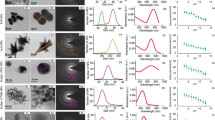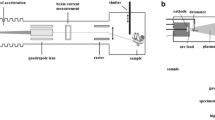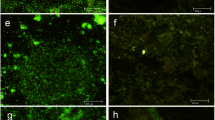Abstract
Antibacterial coatings on catheters for acute dialysis were obtained by an innovative and patented silver deposition technique based on the photo-reduction of the silver solution on the surface of catheter, with consequent formation of antibacterial silver nanoparticles. Aim of this work is the structural and morphological characterization of these medical devices in order to analyze the distribution and the size of clusters on the polymeric surface, and to verify the antibacterial capability of the devices treated by this technique against bacterial proliferation. The structure and morphology of the silver nanoparticles were investigated by using scanning and transmission electron microscopy. The antimicrobial capability of the catheters after silver deposition was confirmed by antibacterial tests with Escherichia coli. Both scanning electron microscopy analysis and antibacterial tests were performed also after washing catheters for 30 days in deionized water at 37°C, relating these data to thermogravimetric analysis and to energy dispersive spectroscopy, in order to check the resistance of coating and its antimicrobial capability after the maximum time of life of these devices.











Similar content being viewed by others
References
Zhao G, Stevens SE. Multiple parameters for the comprehensive evaluation of the susceptibility of Escherichia coli to the silver ion. Biometals. 1998;11:27–32.
Nassar GM, Ayus JC. Infectious complications of the hemodialysis access. Kidney Int. 2001;60:1–13.
Reid G. Biofilms in infectious disease and on medical devices. Int J Antimicrob Agents. 1999;11:223–6.
Dasgupta MK. Biofilms and infection in dialysis patients. Semin Dial. 2002;15:338–46.
Donlan RM. Biofilms and device associated infections. Emerg Infect Dis. 2001;7:277–81.
Shintani H. Modification of medical device surface to attain anti-infection. Trends Biomater Artif Organs. 2004;18:1–8.
Kappell GM, Grover JP, Chrzanowski TH. Micro-scale surface-patterning influences biofilm formation. Electron J Biotechnol. 2009;12:10–1.
De Nardo L, Farè S, Di Matteo V, Cipolla E, Saino E, Visai L, Speziale P, Tanzi MC. New heparinizable modified poly(carbonate urethane) surfaces diminishing bacterial colonization. J Mater Sci Mater Med. 2007;18:2109–15.
Dror N, Mandel M, Hazan Z, Lavie G. Advances in microbial biofilm prevention on indwelling medical devices with emphasis on usage of acoustic energy. Sensors. 2009;9:2538–54.
Francolini I, Donelli G, Stoodley P. Polymer designs to control biofilm growth on medical devices. Rev Environ Sci Biotechnol. 2003;2:307–19.
Sondi I, Salopek-Sondi B. Silver nanoparticles as antimicrobial agent: a case study on E. Coli as a model for gram-negative bacteria. J Colloid Interface Sci. 2004;275:177–82.
Kim JS, Kuk E, Yu KN, Kim JH, Park SJ, Lee HJ, et al. Antimicrobial effects of silver nanoparticles. Nanomedicine. 2007;3:95–101.
Singh M, Singh S, Prasad S, Gambhir IS. Nanotechnology in medicine and antibacterial effect of silver nanoparticles. Dig J Nanomater Biostruct. 2008;3:115–22.
Samuel U, Guggenbichler JP. Prevention of catheter-related infections: the potential of a new nano-silver impregnated catheter. Int J Antimicrob Agents. 2004;23:75–8.
Fung LC, Khoury AE, Vas SI, Smith C, Oreopoulos DG, Mittelman MW. Biocompatibility of silver-coated peritoneal dialysis catheters in a porcine model. Perit Dial Int. 1996;16:398–405.
Schierholz JM, Lucasj LJ, Rump A, Pulverer G. Efficacy of silver-coated medical devices. J Hosp Infect. 1998;40:257–62.
Atiyeh BS, Costagliola M, Hayek SN, Dibo SA. Effect of silver on burn wound infection control and healing: review of the literature. Burns. 2007;33:139–48.
Pollini M, Russo M, Licciulli A, Sannino A, Maffezzoli A. Characterization of antibacterial silver coated yarns. J Mater Sci Mater Med. 2009;20:2361–6.
Phuong Phong NT, Thanh NVK, Phuong PH. Fabrication of antibacterial water filter by coating silver nanoparticles on flexible polyurethane foams. J Phys Conf Ser. 2009;187:012079.
Monteiro DR, Gorup LF, Takamiya AS, Ruvollo-Filho AC, Rodrigues de Camargo E, Barbosa DB. The growing importance of materials that prevent microbial adhesion: antimicrobial effect of medical devices containing silver. Int J Antimicrob Agents. 2009;34:103–10.
Guggenbichler JP, Boswald M, Lugauer S, Krall T. A new technology of microdispersed silver in polyurethane induces antimicrobial activity in central venous catheters. Infection. 1999;27:16–23.
Wolf HH, Leithäuser M, Maschmeyer G, Salwender H, Klein U, Chaberny I, et al. Central venous catheter-related infections in hematology and oncology. Ann Hematol. 2008;87:863–76.
Bambauer R, Latza R, Bambauer S, Tobin E. Large bore catheters with surface treatments versus untreated catheters for vascular access in hemodialysis. Artif Organs. 2004;28:604–10.
Darouiche RO, Raad II, Heard SO, Thornby JI, Wenker OC, Gabrielli A, et al. A comparison of two antimicrobial-impregnated central venous catheters. N Engl J Med. 1999;340:1–8.
Panacek A, Kvıtek L, Prucek R, Milan Kolar M, Renata Vecerova R, Pizurova N, et al. Silver colloid nanoparticles: synthesis, characterization, and their antibacterial activity. J Phys Chem B. 2006;110:16248–53.
Pollini M, Sannino A, Maffezzoli A, Licciulli A. Antibacterial surface treatments based on silver clusters deposition. EP20050850988 (2008-11-05).
Verbeke F, Haung U, Dhondt A, Beck W, Schnell A, Dietrich R, Deppisch R, Vanholder R. The role of polymer surface degradation and barium sulphate release in the pathogenesis of catheter-related infection. Nephrol Dial Transplant. 2010;25:1207–13.
Author information
Authors and Affiliations
Corresponding author
Rights and permissions
About this article
Cite this article
Pollini, M., Paladini, F., Catalano, M. et al. Antibacterial coatings on haemodialysis catheters by photochemical deposition of silver nanoparticles. J Mater Sci: Mater Med 22, 2005–2012 (2011). https://doi.org/10.1007/s10856-011-4380-x
Received:
Accepted:
Published:
Issue Date:
DOI: https://doi.org/10.1007/s10856-011-4380-x




